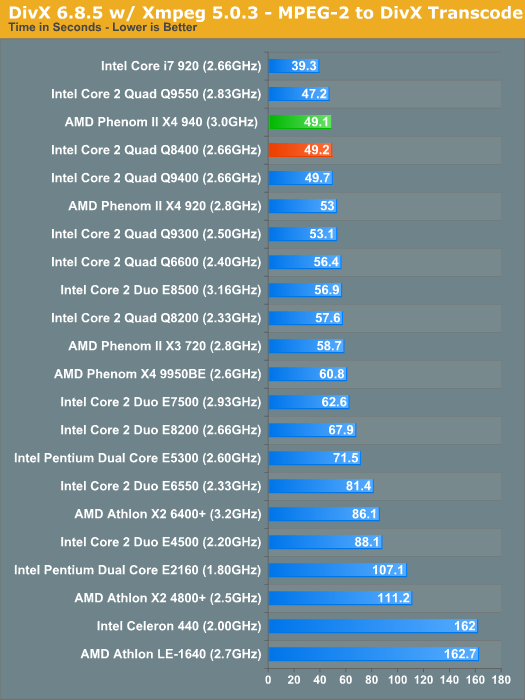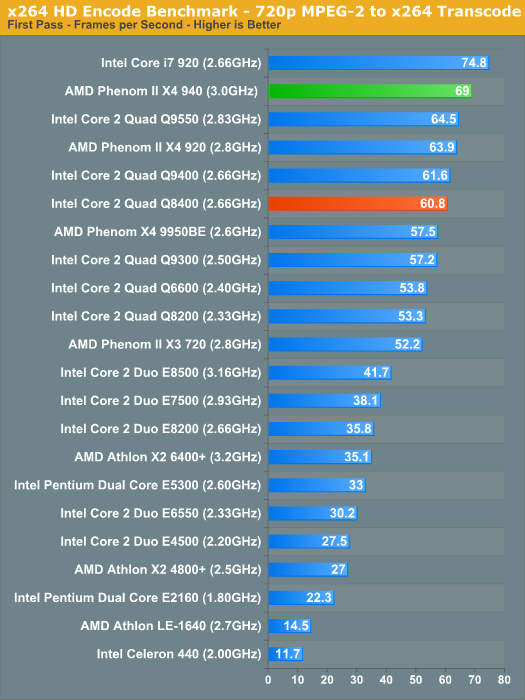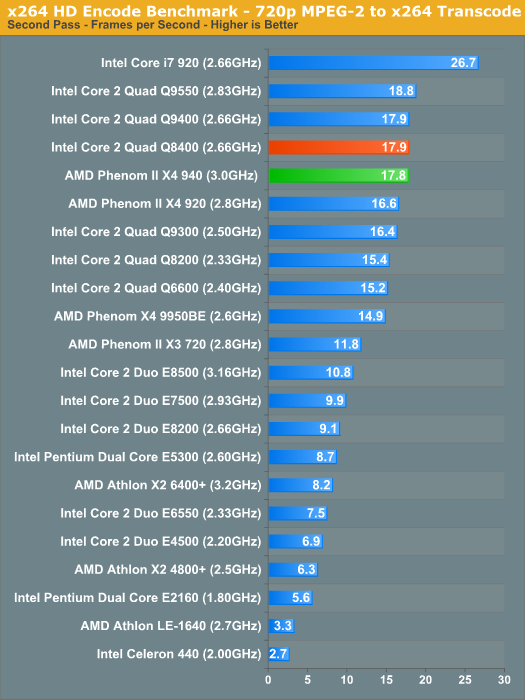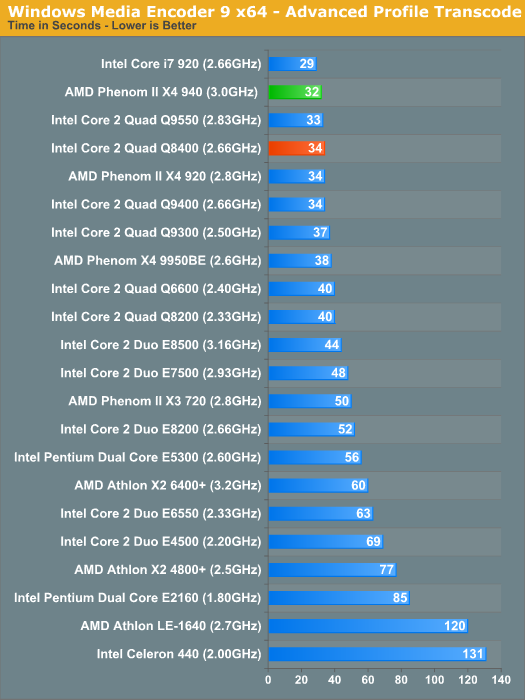The Core 2 Quad Q8400: Intel's $183 Phenom II 940 Competitor
by Anand Lal Shimpi on May 7, 2009 12:00 AM EST- Posted in
- CPUs
DivX 8.5.3 with Xmpeg 5.0.3
Our DivX test is the same DivX / XMpeg 5.03 test we've run for the past few years now, the 1080p source file is encoded using the unconstrained DivX profile, quality/performance is set balanced at 5 and enhanced multithreading is enabled:

Video encoding performance is a tie between our two competitors. Both perform among the fastest quad-core CPUs on the market today, but clearly under the devine i7. Looking at the Pentium E5300 performance we see that even early Core 2 Duo systems stand to see a 30% boost in performance by moving to one of these affordable quad-core alternatives.
If you want to extrapolate however, here's a fun game. It took Intel roughly three years to offer the performance of a $500 CPU in something that costs less than $80. By 2011 you'll be able to get this sort of performance at under $80 as well. Mmm, ubiquitous multi-core.
x264 HD Video Encoding Performance
Graysky's x264 HD test uses the publicly available x264 codec (open source alternative to H.264) to encode a 4Mbps 720p MPEG-2 source. The focus here is on quality rather than speed, thus the benchmark uses a 2-pass encode and reports the average frame rate in each pass.

AMD continues to have a large advantage in two pass x264 encoding thanks to a lot of unaligned loads that penalize Intel's pre-Nehalem architectures. The second, more strenuous pass shows the two contenders in a tie just as we saw in our DivX results:

Windows Media Encoder 9 x64 Advanced Profile
In order to be codec agnostic we've got a Windows Media Encoder benchmark looking at the same sort of thing we've been doing in the DivX and x264 tests, but using WME instead.

While DivX and x264 both showed our contenders as equals, our WME test has the Phenom II 940 in the lead by nearly 6%.










60 Comments
View All Comments
erple2 - Saturday, May 9, 2009 - link
while there may be fewer defects per wafer, there are also fewer chips per wafer (about 57% fewer). To take the analogy to the extreme, lets say that AMD makes one chip that consumes the entire wafer, and Intel can make 2. If there is, on average, 1 defect per wafer for AMD and 5 defects per wafer for Intel, AMD has zero good chips per wafer, and Intel has (on average), 2 good chips per 5 wafers. That example is horribly contrived, sure, but I used it to show that even having a better process (fewer defects per wafer) doesn't guarantee a good result if the size of the chunks you use on the wafer is significantly larger - AMD's can fit quite a few less per wafer (about half?).erple2 - Saturday, May 9, 2009 - link
arg... edit button... Intel would have 1 good chip per 3 wafers. I assumed 4 defects per wafer, not 5 in the 2/5 ...slayerized - Thursday, May 7, 2009 - link
You are confusing yield and throughput - they are two different things.8steve8 - Thursday, May 7, 2009 - link
no Virtualization Tech... so no windows 7 virtual PC, no hyper-v...that sucks.
rather go phenom 2, intel e8xxx or q9xxx
ltcommanderdata - Friday, May 8, 2009 - link
I don't think the lack of VT will be a huge issue for the average consumer. The Q8400 is a budget quad core and OEMs will no doubt be bundling Windows 7 Home Premium with it which doesn't support XP Mode anyways. Tech savy buyers who build their own computers with a Q8400 and Professional Edition would notice, but the larger impediment to XP Mode adoption is probably still Microsoft's production edition matrix.Anand Lal Shimpi - Thursday, May 7, 2009 - link
Very good point, I've updated the conclusion to point out the difference. Honestly it's ridiculous that Intel isn't enabling it on these chips.Take care,
Anand
spazmedia - Thursday, May 7, 2009 - link
I second this. Just bought a intel box with an E5200 thinking it had VT. Hopefully they will follow AMD's lead.GeorgeH - Thursday, May 7, 2009 - link
+1No support for Windows 7 XP Mode is the reason I chose AMD over an Intel Q8X00 in the PC I just built.
leomax999 - Thursday, May 7, 2009 - link
Intel has announced vt support for Q8300, E7400, E7500, E5300, E5400.So i dont see any reason why q8400 shouldnt get it.
http://www.tcmagazine.com/comments.php?shownews=25...">http://www.tcmagazine.com/comments.php?shownews=25...
GeorgeH - Thursday, May 7, 2009 - link
Thanks for the link, but to be clear the chips you listed will never support VT.Intel is supposed to be releasing Q8300".1", E7400".1", etc. chips, but unless they change the model number I can only see that leading to mass confusion. Forcing average people to check the S-Spec or MM number against a list to see what they're actually getting is a classic recipe for fail.
Until those updated Intel chips hit the market, AMD will remain the only real choice for budget and midrange quad core.